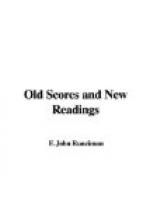I have so often insisted on the pictorial power of Wagner’s music, that, save for one quality of the pictures in the “Ring,” and especially in “Siegfried,” it would be unnecessary to say more about it now. That quality is their old-world atmosphere, their power of filling us with a sense of the old time before us. When the fire plays round Bruennhilde’s fell—Hinde Fell, Morris calls it—lighting the icy tops of the farthest hills, or when Mime and Alberich squabble in the dark of early morning at the mouth of Fafner’s hole, or again when the Wanderer comes in and scarifies Mime out of his wits, we are taken back to the remotest and dimmest past, to the beginnings of time, to a time that never existed save in the imagination of our forebears. This may be partly the result of our unconscious perception of the fact that these things never happen nowadays, and partly the result of our having been familiar with the story of Bruennhilde and the gods since earliest boyhood; but it is in the main due to Wagner’s intense historical sense, his sense of the past, and to his unapproached power of expressing in music any feeling or combination of feelings he experienced. So cunningly do music and scenery work together that we credit the one with what the other has done; but, wonderful though the pictures of “Siegfried” are, there cannot be a doubt that the atmosphere we discover in them reaches us through the ear from the orchestra. Besides giving us a series of singularly apposite and significant pictures, Wagner has reproduced the very breath and colour of the old sagas; he has re-created the atmosphere of a time that never was; and it is this remote atmosphere which lends to “Siegfried” and all the “Ring” a great part of their enchantment. Fancy what it might have been, this long exposition of sheer Schopenhauerism in three dramas and a fore-play! imagine what Parry or Stanford




